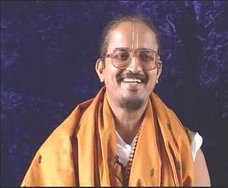Swami Papa Ramdas
Devotion as rightly divided is of two kinds – the lower and the higher. In the lower form of devotion, the devotee looks for guidance and concentration from outside, and primarily attaches himself to the society of saints who have realised fully the greatness and glory of the Lord. To keep himself pure in thought, word and deed, he controls all the forces that are working in his psychical and physical being, and adjusts the conduct of his life so as to free himself from all desires of his mind. Mainly, he will have recourse to three kinds of Sadhana, viz. Satsang, solitude and Sattwic diet. How does the devotee now try to tune his mind in a continuous symphony with the Lord? It must be admitted that every remembrance signifies bringing into the mind the name and qualities of the person or object remembered. A prolonged remembrance means a sustained fixity of the thought on the name and attributes of the person or object. For the devotee, the Lord becomes the one great object of ceaseless remembrance, which is attained by an unbroken repetition of His sweet and all-powerful Name and bringing at the same time into the mind His sublime glories and attributes.
As the devotee advances in this spiritual path, he transcends the Tamo and Rajo Gunas of nature and gets firmly seated in Sattwa Guna. Sattwa Guna denotes a consciousness above the animality of human nature, filled with calmness, equality, light and purity. It must be understood that this Sattwic consciousness is a step to a still higher consciousness. The lower form of Bhakti leads the devotee to this most necessary step.
Now commences the higher aspect of devotion. Sattwa Guna entitles the devotee to the Grace of the Lord or a saint, and through this grace he is lifted beyond all Gunas and comes, so to say, face to face with the immortal and all-blissful Atman whom he realises as his real being and existence. This is called Jnana or Moksha. The knowledge of the Atman liberates the bound soul from the vicious cycle of births and deaths and grants him unchanging and eternal bliss and peace. It is then the higher Bhakti which is termed Parabhakti dawns on him. This is the summit of God-realisation. With Jnana as the background, the devotee beholds the entire manifested universe as the supreme image of his beloved Lord. All creatures, beings and things in the universe are looked upon by him as the very forms of his Lord. He feels and sees the Lord's presence everywhere. His sense of duality has completely vanished. Oneness of life, oneness of all existence becomes now the keynote of his vision. Not only in the inner realisation of the Atman that the sense of diversity has disappeared but also in the external revelations of the natural phenomena. In this supreme state the devotee enjoys unending and inexpressible bliss. There is no limit to his ecstasies born of his consciousness of unity and oneness with the Lord. He veritably rolls, swims and gambols in the infinite ocean of joy. Blessed, a million times blessed, is the devotee who reaches this highest peak of God-realisation.
Chant the Mahamantra Nama kirtan :
Hare Rama Hare Rama Rama Rama Hare Hare
Hare Krishna Hare Krishna Krishna Krishna Hare Hare

No comments:
Post a Comment